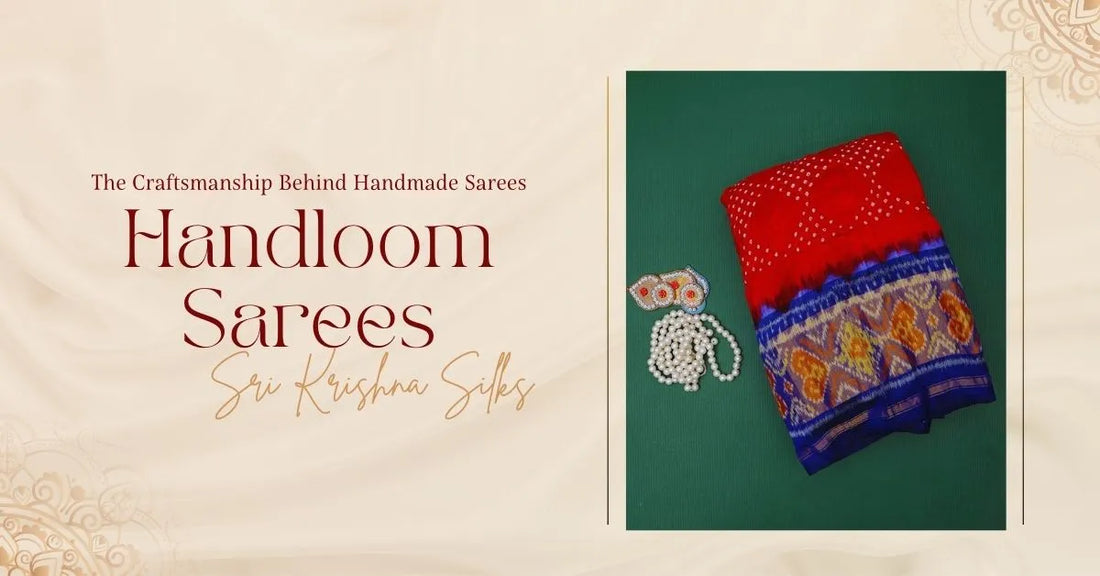Handloom Sarees: The Craftsmanship Behind Handmade Sarees
Handloom sarees, with their intricate weaves and timeless elegance, hold a special place in the fashion world. They are not merely pieces of fabric but embodiments of rich cultural heritage, representing the artistry and craftsmanship passed down through generations. Each handloom saree tells a story of tradition, skill, and the dedication of artisans who pour their heart and soul into creating these exquisite garments.
The Significance of Handloom Sarees

Handloom sarees are celebrated for their uniqueness and individuality, attributes that are increasingly rare in today’s age of mass production. Unlike machine-made sarees, each handloom saree is a labor of love, often taking days, weeks, or even months to complete. The detailed process ensures that no two sarees are exactly alike, offering exclusivity to the wearer. Additionally, handloom sarees are eco-friendly, using natural fibers like cotton and silk, and often employing traditional dyeing methods that are less harmful to the environment.
The Art of Weaving
The creation of a handloom saree begins with the preparation of the yarn. Cotton, silk, or other natural fibers are spun into threads, which are then dyed using natural or synthetic dyes. The threads are carefully arranged on the loom, a process known as warping, where the lengthwise threads (warp) are set up. The weaving process involves interlacing the warp with the weft (crosswise threads), creating the fabric.
There are various techniques used in handloom weaving, each contributing to the distinct characteristics of different regional sarees. For instance:
- Kanjeevaram Sarees: Originating from Tamil Nadu, these sarees are known for their rich, vibrant colors and heavy silk fabric. The intricate patterns are often inspired by temple architecture, nature, and mythological stories.
- Banarasi Sarees: From Varanasi, these sarees are renowned for their abundant brocade work, featuring gold and silver threads. The designs often include intricate floral and foliate motifs, inspired by Mughal art.
- Bandhani Sarees: Popular in Gujarat and Rajasthan, these sarees are characterized by their tie-dye patterns. The fabric is tied tightly at various points before dyeing, creating distinctive patterns when the ties are removed.
-
Patola Sarees: From Patan in Gujarat, Patola sarees are double ikat woven, meaning both the warp and weft threads are resist-dyed before weaving. This results in intricate geometric patterns and vibrant colors.

The Role of Artisans
The creation of a handloom saree is a collaborative effort, involving various artisans specializing in different aspects of the process. The master weaver oversees the entire process, ensuring the design and quality of the saree. Dyeing experts handle the complex task of preparing and applying colors to the threads. Embroiderers and embellishers add intricate details, such as zari work (gold or silver thread embroidery), beads, and sequins.
Artisans often inherit their skills through generations, with knowledge and techniques passed down within families. This traditional knowledge is crucial in maintaining the authenticity and quality of handloom sarees. However, the art of handloom weaving faces challenges in the modern era, including competition from machine-made textiles and a declining number of skilled weavers.
Cultural Impact and Preservation
Handloom sarees are more than just clothing; they are cultural artifacts that reflect the history, traditions, and identities of various Indian communities. They play a significant role in festivals, weddings, and other ceremonial occasions, symbolizing purity, elegance, and cultural pride.
Efforts to preserve and promote handloom sarees include government initiatives, such as the Handloom Mark, which certifies the authenticity of handloom products. Additionally, various NGOs and fashion designers are working to revitalize the handloom sector by introducing contemporary designs and marketing strategies that appeal to younger generations.
Conclusion
Handloom sarees represent the epitome of craftsmanship, where each piece is a testament to the weaver's skill, creativity, and dedication. They are woven not just with threads, but with the cultural heritage and artistic expression of India. Preserving this art form is essential for maintaining the diversity and richness of our cultural landscape. By choosing handloom sarees, we support the artisans who keep this timeless craft alive, ensuring that the beauty and tradition of handloom weaving continue to be cherished for generations to come.



